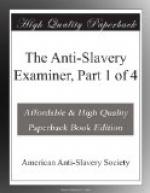[Footnote A: Whatever system sinks men from an END to a mere means, just so far makes him a slave. Hence West India apprenticeship retains the cardinal principle of slavery. The apprentice, during three fourths of his time, is still forced to labor, and robbed of his earnings; just so far forth he is a mere means, a slave. True, in other respects slavery is abolished in the British West Indies. Its bloodiest features are blotted out—but the meanest and most despicable of all—forcing the poor to work for the rich without pay three fourths of their time, with a legal officer to flog them if they demur at the outrage, is one of the provisions of the “Emancipation Act!” For the glories of that luminary, abolitionists thank God, while they mourn that it rose behind clouds, and shines through an eclipse.]
That this is American slavery, is shown by the laws of slave states. Judge Stroud, in his “Sketch of the Laws relating to Slavery,” says, “The cardinal principle of slavery, that the slave is not to be ranked among sentient beings, but among things—obtains as undoubted law in all of these [the slave] states.” The law of South Carolina thus lays down the principle, “Slaves shall be deemed, held, taken, reputed, and adjudged in law to be chattels personal in the hands of their owners and possessors, and their executors, administrators, and assigns, to ALL INTENTS, CONSTRUCTIONS, AND PURPOSES WHATSOEVER.”—Brevard’s Digest, 229. In Louisiana, “A slave is one who is in the power of a master to whom he belongs; the master may sell him, dispose of his person, his industry, and his labor; he can do nothing, possess nothing, nor acquire any thing, but what must belong to his master.”—Civ. Code of Louisiana, Art. 35.
This is American slavery. The eternal distinction between a person and a thing, trampled under foot—the crowning distinction of all others—alike the source, the test, and the measure of their value—the rational, immortal principle, consecrated by God to universal homage, in a baptism of glory and honor by the gift of His Son, His Spirit, His word, His presence, providence, and power; His shield, and staff, and sheltering wing; His opening heavens, and angels ministering, and chariots of fire, and songs of morning stars, and a great voice in heaven, proclaiming eternal sanctions, and confirming the word with signs following.




